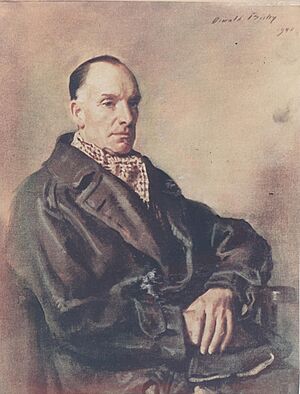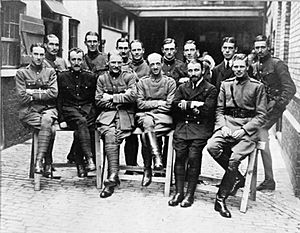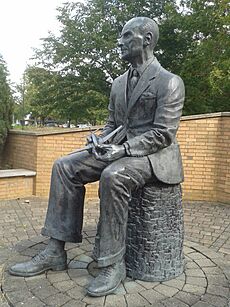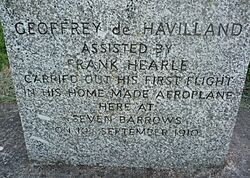Geoffrey de Havilland facts for kids
Quick facts for kids
Geoffrey de Havilland
|
|
|---|---|

Painting of de Havilland
|
|
| Born | 27 July 1882 High Wycombe, Buckinghamshire, England
|
| Died | 21 May 1965 (aged 82) Watford, Hertfordshire, England
|
| Nationality | British |
| Education | Crystal Palace School of Engineering |
| Occupation | Aircraft engineer |
| Spouse(s) |
Louise Thomas
(m. 1909; died 1949)Joan Mary Frith
(m. 1951) |
| Children | 3 sons, including Geoffrey Jr. and John |
| Relatives | Hereward de Havilland (brother) Dame Olivia de Havilland (cousin) Joan Fontaine (cousin) |
| Military career | |
| Allegiance | |
| Service/ |
|
| Years of service | 1912–1919 |
| Rank | Captain |
| Unit | Royal Flying Corps |
| Battles/wars | First World War |
| Awards | Air Force Cross (AFC) Officer of the Order of the British Empire (OBE) |
Captain Sir Geoffrey de Havilland (born July 27, 1882 – died May 21, 1965) was a famous English aviation pioneer and aerospace engineer. He started an aircraft company that created many important planes. Two of his most famous designs were the Mosquito and the Comet. The Mosquito was a very flexible warplane used in World War II. The Comet was the first jet airliner ever made.
Contents
Early Life and First Steps
Geoffrey de Havilland was born in High Wycombe, England. He was the second son of Charles de Havilland and Alice Jeannette. He went to engineering school at the Crystal Palace School of Engineering. He studied there from 1900 to 1903.
After school, Geoffrey first worked with cars and motorcycles. He trained with engine makers and then worked as a designer. He even designed his very first aircraft engine during this time. In 1909, he got married. Soon after, he began his lifelong journey of designing, building, and flying airplanes.
Building a Dream: Aviation Career
Geoffrey de Havilland borrowed money from his grandfather to build his first airplane. It took him two years to finish it. Sadly, it crashed during its first short flight in December 1909. But Geoffrey didn't give up! He built a new biplane. He made his first successful flight in this new plane in September 1910.
In 1912, he set a new British altitude record. He flew 10,500 feet (3,200 meters) high in an aircraft he designed, the B.E.2. His brother, Hereward, was the test pilot for this flight.
In December 1910, de Havilland started working at the HM Balloon Factory. This factory later became the Royal Aircraft Factory. He sold his second airplane to them for £400. This plane became the F.E.1. For the next three years, he designed many experimental aircraft there. He also joined the Royal Flying Corps as an officer in 1912.
In 1914, Geoffrey became the chief designer at a company called Airco. He designed many planes for Airco, and they were all named with his initials: "DH." Many of his DH aircraft were used during the First World War. He continued to serve in the Royal Flying Corps during the war.
After the war, Airco was shut down. But Geoffrey de Havilland didn't stop. With help from a former Airco owner, he started his own company. It was called the de Havilland Aircraft Company. He hired some of his old colleagues. A man named Alan Butler provided money to buy a new location and an airfield. There, they designed and built many planes, including the famous Moth series. Geoffrey himself often tested the company's new aircraft.
In 1928, a branch of the company, De Havilland Canada, was opened in North America. This helped build more planes, especially during World War II. After the war, De Havilland Canada designed its own successful aircraft. In 1933, the main company moved to Hatfield Aerodrome in Hertfordshire.
In 1944, de Havilland bought a company from his friend Frank Halford. This became the de Havilland Engine Company. Halford had designed many engines for de Havilland before. His first jet engine design was the de Havilland Goblin. This engine powered de Havilland's first jet plane, the Vampire.
Geoffrey de Havilland managed his company until it was bought by the Hawker Siddeley Company in 1960.
Retirement and Later Life
Geoffrey de Havilland retired from his company in 1955. However, he remained its president. He continued to fly planes until he was 70 years old! He passed away on May 21, 1965, at the age of 82.
Awards and Recognition
Geoffrey de Havilland received many honors for his work. He was made an Officer of the Order of the British Empire (OBE) in 1918. He also received the Air Force Cross (AFC) in 1919 for his service in World War I. In 1934, he became a Commander of the British Empire (CBE).
In 1944, he was made a Knight by King George VI. This means he could be called "Sir Geoffrey." In 1962, he was given the Order of Merit (OM), a very special honor. He also received many gold and silver medals for his achievements in aviation.
In 1972, de Havilland was added to the International Air & Space Hall of Fame. This recognizes people who have made huge contributions to air and space travel.
A statue of Geoffrey de Havilland was put up in 1997. It is near the University of Hertfordshire in Hatfield. He had given land to the county council in 1951 for a college, which later became part of this university. The Duke of Edinburgh unveiled the statue. A campus at the university is also named "De Havilland" in his honor.
Family Connections
Geoffrey de Havilland had some famous relatives. The actresses Olivia de Havilland and Joan Fontaine were his first cousins. His younger brother, Hereward de Havilland, was also a well-known pilot and test pilot.
In 1909, Geoffrey married Louise Thomas. They had three sons: Peter, Geoffrey, and John. Sadly, two of his sons died while testing de Havilland aircraft. His youngest son, John, died in a plane collision in 1943.
His son, Geoffrey Jr., was also a test pilot. He flew the first flights of the Mosquito and Vampire jets. He died in 1946 while testing a jet-powered plane called the DH 108 Swallow. He was flying at or near the speed of sound. After these tragedies, Louise passed away in 1949. Geoffrey remarried in 1951 to Joan Mary Frith. They were married until his death.
| de Havilland family tree | ||||||||||||||||||||||||||||||||||||||||||||||||||||||||||||||||||||||||||||||||||||||||||||||||||||||||||||||||||||||||||||||||||||||||||||||||||||||||||||||||||||||||||||||||||||||||||||||||||||||||||||||||||||||||||||||||||||||||||||||||||||||||||||||||||||||||||||||||||||||||||||||||||||||||||||||||||||||||||||||||||||||||||||||||||||||||||||||||||||||||||||||||||||||||||||||||||||||||||||||||||||||||||||||||||||||||||||||||||||||||||||||||||||||||||||||||||||||||||||||||||||||||||||||||||||||||||||||||||||||
|---|---|---|---|---|---|---|---|---|---|---|---|---|---|---|---|---|---|---|---|---|---|---|---|---|---|---|---|---|---|---|---|---|---|---|---|---|---|---|---|---|---|---|---|---|---|---|---|---|---|---|---|---|---|---|---|---|---|---|---|---|---|---|---|---|---|---|---|---|---|---|---|---|---|---|---|---|---|---|---|---|---|---|---|---|---|---|---|---|---|---|---|---|---|---|---|---|---|---|---|---|---|---|---|---|---|---|---|---|---|---|---|---|---|---|---|---|---|---|---|---|---|---|---|---|---|---|---|---|---|---|---|---|---|---|---|---|---|---|---|---|---|---|---|---|---|---|---|---|---|---|---|---|---|---|---|---|---|---|---|---|---|---|---|---|---|---|---|---|---|---|---|---|---|---|---|---|---|---|---|---|---|---|---|---|---|---|---|---|---|---|---|---|---|---|---|---|---|---|---|---|---|---|---|---|---|---|---|---|---|---|---|---|---|---|---|---|---|---|---|---|---|---|---|---|---|---|---|---|---|---|---|---|---|---|---|---|---|---|---|---|---|---|---|---|---|---|---|---|---|---|---|---|---|---|---|---|---|---|---|---|---|---|---|---|---|---|---|---|---|---|---|---|---|---|---|---|---|---|---|---|---|---|---|---|---|---|---|---|---|---|---|---|---|---|---|---|---|---|---|---|---|---|---|---|---|---|---|---|---|---|---|---|---|---|---|---|---|---|---|---|---|---|---|---|---|---|---|---|---|---|---|---|---|---|---|---|---|---|---|---|---|---|---|---|---|---|---|---|---|---|---|---|---|---|---|---|---|---|---|---|---|---|---|---|---|---|---|---|---|---|---|---|---|---|---|---|---|---|---|---|---|---|---|---|---|---|---|---|---|---|---|---|---|---|---|---|---|---|---|---|---|---|---|---|---|---|---|---|---|---|---|---|---|---|---|---|---|---|---|---|---|---|---|---|---|---|---|---|---|---|---|---|---|---|---|---|---|---|---|---|---|---|---|---|---|---|---|---|---|---|---|---|---|---|---|---|---|---|---|---|---|---|---|---|---|---|---|---|---|---|---|---|---|---|---|---|---|---|---|---|---|---|---|---|---|---|---|---|---|---|---|---|---|---|---|---|---|---|---|---|---|---|---|---|---|---|---|---|---|---|---|---|---|---|---|---|---|---|
|
||||||||||||||||||||||||||||||||||||||||||||||||||||||||||||||||||||||||||||||||||||||||||||||||||||||||||||||||||||||||||||||||||||||||||||||||||||||||||||||||||||||||||||||||||||||||||||||||||||||||||||||||||||||||||||||||||||||||||||||||||||||||||||||||||||||||||||||||||||||||||||||||||||||||||||||||||||||||||||||||||||||||||||||||||||||||||||||||||||||||||||||||||||||||||||||||||||||||||||||||||||||||||||||||||||||||||||||||||||||||||||||||||||||||||||||||||||||||||||||||||||||||||||||||||||||||||||||||||||||
Books About Him
In 1975, Geoffrey de Havilland's autobiography, Sky Fever, was republished. An autobiography is a book written by the person themselves about their own life. He first published it in 1961.
See also
- de Havilland Aircraft Museum, London Colney, Hertfordshire
Images for kids






